The reporting for this article was made possible with a grant from NACLA’s Samuel Chavkin Investigative Journalism Fund. To read part one of this story, please click here.
Chocó: Dragones and Destruction
In the mornings, residents of the tiny river community of Villa Claret descend a steep cement staircase that leads to the Capa River. Some carry a towel on their shoulders while holding bars of soap, ready to dive in. Some bring baskets of clothes to wash in the river.
One morning in May, an 11-year-old girl rushed down to the river’s edge with her little brother to catch some fish for breakfast. Using a unique technique involving a plastic soda bottle and a piece of plantain as bait, she dove swiftly time and again into the water and caught four sardines.
Such activities by the river— swimming, fishing, washing clothes— could be irrevocably changed if mining continues to expand beyond the nearby Atrato River and into the small rivers like Capa that host indigenous and Afro-Colombian communities like Villa Claret.
Villa Claret is located in the rainforest of the Chocó department in Colombia’s pacific northwest. It is reached by taking a long narrow wooden boat up the Atrato River to the Capa River. Like many indigenous and Afro-Colombian communities throughout Chocó, Villa Claret is not connected to any roads.
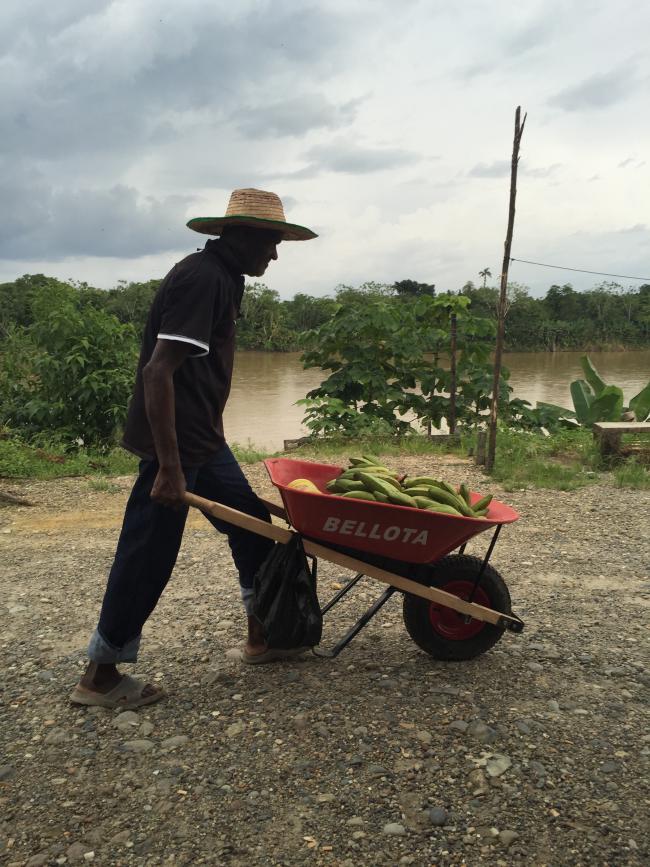
Residents of Villa Claret, like many other river-based communities, survive by growing small plots of yucca, pineapple, sugarcane, and other plants. They also raise animals, fish, and pan for gold. But today they are afraid to eat fish from the Atrato River because of mercury contamination from mining, including from large hulking dragones and smaller dragas stationed along the river.
The existence of large illegal mining operations means that artisanal miners find significantly less gold, they report, and the presence of armed groups involved in mining has forced some to abandon the riverside plots of land they used to farm. While the riverbeds are rich with gold, the people who live along them survive mostly in abject poverty.
In early May, a small dredging operation was established in Villa Claret, on a rocky beach located below small wooden homes where women boil sugar cane into a golden syrup in large pots above fires, and elderly relatives sit on a porch drinking that syrup mixed with river water. Residents said they are not overly concerned with the mining dredge run by a local resident, though such operations are known to have serious impacts on river ecology.
But Villa Claret residents are very upset about the large dragones extracting gold on the Atrato River. The dragones do not have legal permission to operate nor do they hold title to the minerals, but there is nothing clandestine about them. One is proudly emblazoned with a reference to another town on the river, and locals say it is owned or run by officials from there. Last year, a dragon sprung up on the Atrato River alongside the small town of Arenal. Locals say it is illegally operated, they think by Brazilian migrants. Small wooden shacks built on a muddy hill just behind the main street house its workers, one local resident said.
As menacing dark gray clouds gathered on a Sunday in late May, Davison Sanchez Gómez ducked out of a Mother’s Day party in Arenal complete with pulsing dance rhythms, traditional sancocho soup, and fiery aguardiente. Gómez, 33, a community organizer wearing a stylish green shirt and appliques of flies on his fingernails, said that “gold fever” has been bad for the community. While several locals work for the recently arrived dragón, he said that such operations have brought only upheaval and contamination to communities like Arenal.
He wishes the government would help the community pool resources to start gold mining cooperatives that could keep profits within the community and encourage sustainable practices, instead of forcing locals to seek employment with these outside, “illegal” miners.
“Due to poverty the locals accept the conditions of [outside miners] and since we are the ones in need, then we have to agree,” Gómez said. “But if we didn’t have the need, we would not let them in because we consciously know that mining...destroys everything.”
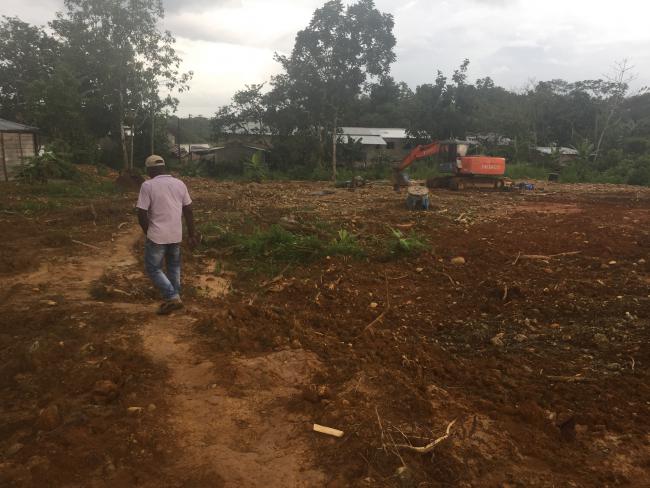
Father Sterlin Londoño from the nearby Diocese of Quibdo and community members established a committee focused on environmental sustainability twenty years ago. Today, the committee focuses on illegal mining on the rivers and in the rainforest. Londoño said that illegal mining adds to the mosaic of problems facing the riverine Afro-Colombian and indigenous communities, who have struggled to survive for decades despite government neglect and civil war.
In 2011, the Colombian government granted a collective land title to COCOMOPOCA, a confederation of Chocó Afro-Colombian communities, which includes Villa Claret and Arenal. But the title granted only about half the land that COCOMOPOCA sought– 73,000 hectares. Later, COCOMOPOCA leaders and advocates said they discovered that AngloGold Ashanti also holds a competing mining title covering about 50,000 of those same hectares. (AngloGoldAshanti did not answer emailed questions or provide comment for this story.)
While residents worry about future mining by the multinational corporation, they feel more immediately threatened by illegal mining. Londoño cited a municipal order demanding that the national police remove illegal mining and dredging machinery.
But, according to Londoño, the national police have said they lack the resources to curb illegal mining on the rivers. Meanwhile, the order is “controversial,” he said, because as in Cauca, locals fear armed groups will punish them if the government impedes their mining. “If they remove machines, community leaders will be killed by armed groups,” Londoño said. “A lot of people will be killed.”
Marmato: Locals Versus Multinationals
For centuries, gold mining has been the economic lifeblood of Marmato, a town clinging to the steep slopes of a mountain laden with gold in the department of Caldas.
Yamil Amar Cataño has been a miner in the town of Marmato for decades. On Sunday afternoons, he sits at the back of El Porvenir, a local cafeteria that overlooks the hills.
Residents like Cataño have long mined the steep, crumbling slopes and refined the gold in nearby makeshift mills. Going up the unpaved road that leads to Marmato, it’s easy to spot the tunnel entrances gaping in the mountainside, the gashes from open-air mining, and the roofs of the mills where water and cyanide coax the gold from rock.
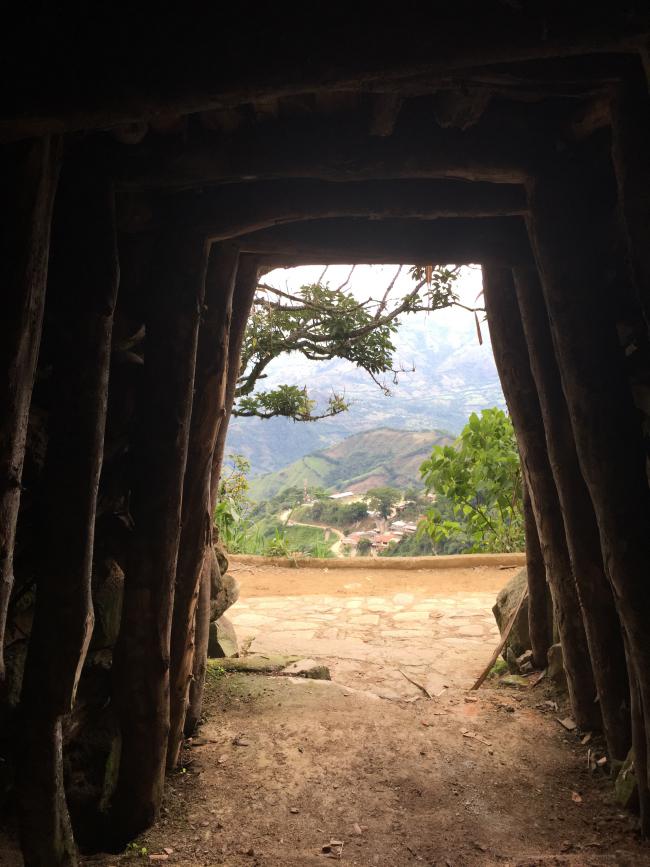
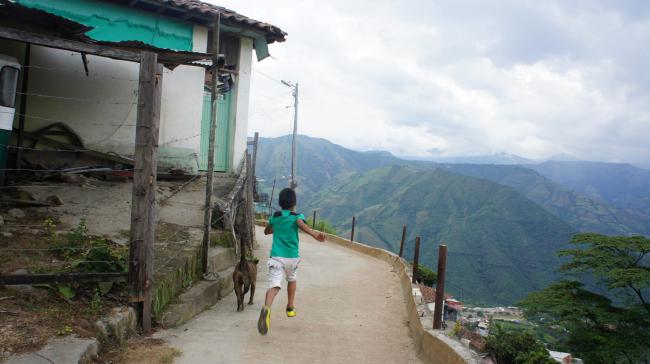
Since 2009, Gran Colombia Gold and the company Medoro Resources, which has since merged with Gran Colombia, have acquired extensive mineral rights in Marmato. Gran Colombia’s website says there are about 14 million ounces of gold and about 90 million ounces of silver in the deposit. Some of these mineral rights have encroached on “special mining districts” in Marmato that were set aside in the 1940s for small and medium-scale mining.
But for the past decade Marmato miners have fought to retain the rights to their mines and for the very existence of their town, since multinational companies have obtained mineral titles and put forth plans to transform the area into large industrial mines.
In the old days, the Marmato miners say, they were easily able to get titles to mineral rights. Miners could sell their titles, and if the mine was abandoned, it would go back to the state, which would in turn grant the mine to any new requestor. But after the mining code changed in 2001, foreign investors were easily able to acquire titles to the areas that locals had been mining. As shown in the documentary “Marmato” and described by Marmato residents, after multinationals took interest in the area, Colombian government officials began blaming locally-based mining for causing landslides.
Company and government officials said it was no longer safe for residents to live in the town because of these landslides. As a result, officials proposed to move residents to a nearby town lower down the mountain to clear the way for more mining in Marmato. They also promised new jobs to the community and the use of better mining technology.
“To develop an open pit-mining project, the town of Marmato needed to be evacuated,” Cataño said. “What we don’t consider right is that because of some financial interests, we would have to leave our town.”
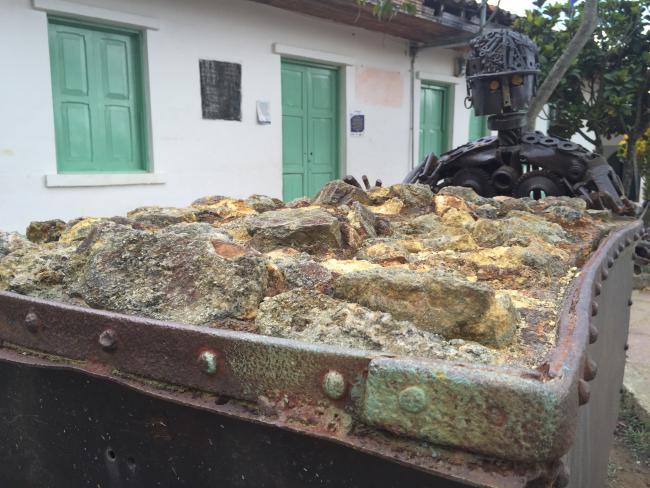
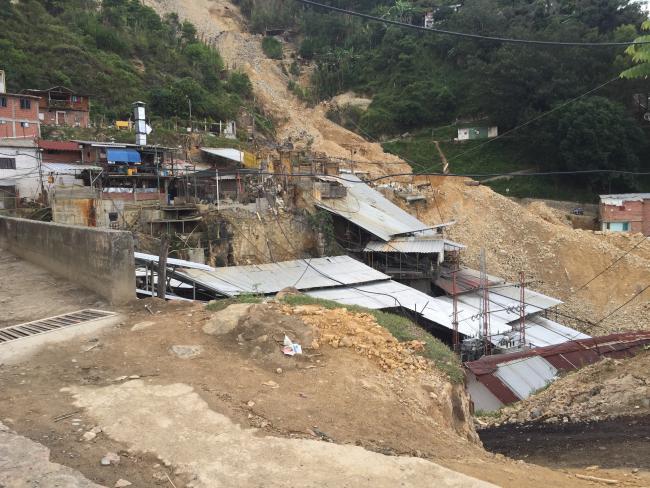
As Cataño and others see it, the multinationals, in collaboration with the government and the local media, tried to convince some locals to sell their mines and mills, in part because of the argument that the town had become unsafe. Cataño said some local miners sold their mines thinking they would make a good profit and went to other cities to establish businesses. But some of these ventures failed and many of them ended up coming back not as mine owners but as laborers, Cataño said.
Meanwhile, even after the company had forced or persuaded some local miners to abandon their operations, the company did not begin mining itself on all those areas – meaning the jobs and economic stimulation promised did not materialize, according to locals.
“The company acquires titles over some of the mines, doesn’t work them, and abandons them,” said Eulises Lemus-García, a leader of the Civic Committee for the Defense of Marmato. “That company left 833 people unemployed. That’s a very high impact for such a small town.”
Today small- and medium-scale mining continues in Marmato, including at Cataño’s three mines, which are now managed by his sons. But it has become less economically viable than it was in years past. The bans on dynamite have forced local miners to use illegal and more dangerous homemade explosives, called pólvora blanca (white gunpowder).
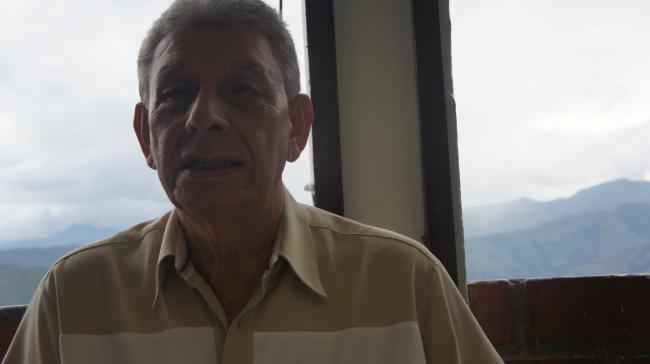
“Right now we are losing money in mining,” Cataño said. “Dynamite gives more performance; [pólvora blanca] is more dangerous and pays less.”
Cataño said more than 30 local miners have been injured using homemade explosives. “Some are now blind, some are mutilated. They were not used to working with homemade stuff, and now several miners have also died.”
Some Marmato miners are trying to legalize their operations through the government’s new formalization process, but like other small miners around the country, they find the process very difficult. “In order to fulfill those requirements you need the advice of a lawyer, environmentalists, an engineer, a geologist and do so many things that cost a lot of money and are impossible for small miners,” Cataño said.
Today, Gran Colombia Gold has operations in Marmato. Some 6,391 ounces of gold and 9,514 ounces of silver were produced in Marmato during the third quarter of 2015, according to the company’s website. A Gran Colombia Gold spokesperson did not respond to emailed questions.
Despite this ongoing production, locals feel the multinational companies have, at least for the time being, largely pulled back from the town largely because of the lowered price of gold.But miners worry that when gold prices rise, the companies will return and resume their efforts to displace locals.
However, now that their situation has garnered the attention and support of union leaders, indigenous groups, academics, international and labor right coalitions, miners, and residents of Marmato say they are ready to fight back. “We have become a rebellious group,” Cataño said. “We dance when they play. We come out when the moment is right.”
Jardín and Jericó: Green or Gold?
Known for its colorful houses and flower-filled balconies, the town of Jardín is nestled in the hills of the southwest region of Antioquia. Pure waterfalls, coffee, and banana plantations surround the town, famous for its architecture, culture, and ecotourism. But residents and local leaders fear this could all be at risk, since the area is also considered rich in gold and potentially lucrative for multinational companies.
Local residents of Jardín remember when they first noticed the looming presence of multinational mining companies. Some say back in 2010 they saw helicopters flying over their town carrying a device that measures magnetic fields and detects deposits of gold and other minerals from the air.
Unlike Marmato, with its rich history of small-scale mining, in Jardín locals have long opposed even small-scale mining. In past years, miners from Northern Antioquia and lower Cauca mining towns like Segovia or Remedios tried to conduct informal medium-scale open pit mining in Jardín, according to Germán Buitrago-Franco, a representative of the municipal government’s environment and rural development agency. But opposition from local government officials and residents largely deterred them.
Mining by multinational corporations, however, poses a greater risk entirely, Buitrago-Franco and other locals feel. The area’s economy has long depended on coffee, sugar cane, banana, and trout farms that rely on the pure waters that stream directly from the mountaintops. For many farmers in the region, much of the land they work has historically been dedicated to agriculture and ecotourism. But in recent years, they feel it is at risk of becoming a land filled with open pit mines and related contamination. Experts from Censat Agua Viva, an environmental organization in Jardín, worry about the serious environmental impacts and potentially irreversible consequences of open-pit mining and processing that involves mercury and cyanide.
For more than five years, resistance to corporate gold mining has grown in the coffee axis of Colombia, centered around the Southwest region of the department of Antioquia, which includes the towns of Jardín, Támesis, Jericó, Caramanta, and Pueblorrico.
Buitrago-Franco says that soon after local officials and residents realized that multinationals were exploring and looking to start open-pit mining in the area, the community began to organize, including against the speculators and explorers evaluating mineral resources.
He and other locals formed a coalition called Cinturón Occidental Ambiental, or the Western Environmental Belt, a group that is composed of social and environmental organizations and several local mayors determined to prevent mining in their towns.
“We are always alert to who enters and who exits the town,” he said. “We denounce them through social media, and inform local authorities. We let them know that we don’t want them in our territory.”
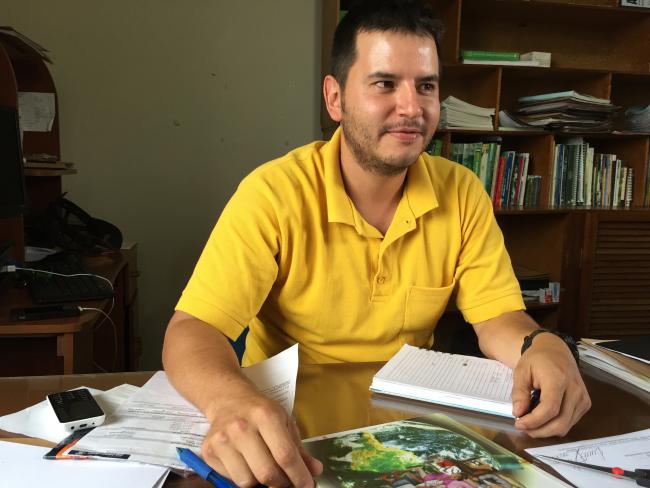

According to local media outlets, Antioquia’s Ministry of Mines of Antioquia has made 22 authorizations to advance exploration in 39,000 hectares in the area, nearly half the territory of the five aforementioned towns. The Ministry of Mines did not respond to requests for comment.
The Jardín City Council has been trying to push forward legislation that would block large-scale mining. “We have never been miners. For us the large-scale mining would be a disgrace. The essence of the municipality would be lost,” Jardín mayor Alvaro Aníbal Carvajal explained to the local press in 2012. Town leaders in nearby Caramanta, Tamesis, and Pueblorrico echoed his concerns.
Last February, the mayor from the municipality of Pueblorrico, Flavio Enrique Fajardo Sierra, sent a letter to the local council asking them to approve a referendum declaring collective rights to life, water, and territory as sacred and superior over any mining, energy, commercial, or extractive project.
“They [the government and the multinationals] talk about responsible mining, but we really don’t know the first case of responsible mining in the area,” said Buitrago-Franco. “From an economic point of view, we understand that the earnings go to the mining companies; they are not going to stay in our town.”
However, not every town in the coffee axis opposes mining unanimously. It is a polarizing issue in Jericó, a town with significant agricultural production especially in coffee and bananas. Jericó is located 30 miles from Jardín. The land around the town is also rich in copper, silver, and molybdenum. AngloGold Ashanti has been exploring for gold and copper in the area, an operation it calls the Quebradona project.
Supporters in Jericó argue that mining represents the essence of development. Over the years, the company has won support from locals in part by offering transportation subsidies for residents, and resources for schools, including footballs, art supplies, and the construction of new classrooms. Residents who are tired of the instability and low wages of agricultural jobs have also argued that the company has brought sustainable employment, and therefore financial stability, to their families.
But the growing presence of mining has already altered life in Jericó and changed the town’s whole identity, locals report. Traditional coffee farming suffers as workers turn instead to the mines. An influx of outsiders has also meant more social problems. Many farmers blame AngloGold Ashanti for what they describe as decreasing water supplies in nearby rivers and lagoons. They also blame the government for awarding mineral titles to the company. In 2014, Jericó residents who oppose mining, mostly farmers from the community of Palo Cabildo, organized a blockade against AngloGold Ashanti, the third largest gold producer in the world.
Ultimately, across the coffee axis, many farmers, environmentalists, and other residents opposed to mining argue that the area’s true “gold” is not yellow, but green— the fruits of the earth that have sustained them for centuries, and the ecotourism that has become a healthy business in more recent decades.
Carlos Alberto Gómez, an attorney and member of the local environmental coalition in Jardín, compares foreign companies’ current interest in gold to the era of the conquistadores half a millennium ago.
“This is what brings us here today: the defense of our territory against the ambitious and inordinate gold fever of foreigners,” he said. “Just like 500 years ago, when they came and took our gold, leaving behind only extinction and a long record of harassment, humiliation and predation.”
Multinational Mining: A Runaway Train?
Roller Escobar Gómez is a young leader, based in the southern city of Cali, who works closely with different Afro-Colombian groups opposed to mining. He faces frequent threats because of his work. This spring, he said, bullets were fired at his car.
Meeting in the safety of a Cali hotel, he began to cry as he described the moment that his driver was shot in the face, miraculously surviving. He has also faced threats in the form of a car parked repeatedly and conspicuously outside the home he shares with his wife and two daughters, he said.
At a “typical” illegal mine in these regions, Escobar explained, a guerrilla group might control the area while a paramilitary group provides “security.” Local residents, Afro-Colombian and indigenous, often along with “paisas from Antioquia— are hired to do the work. Not only is the mining an “environmental disaster,” Escobar says, but it has brought prostitution and violence to once-bucolic communities. He feels like the multinational companies, which in many cases hold the mineral rights, are also complicit in the whole situation.
President Santos has branded mining a “locomotive” or “engine” for the country’s economy. In this spirit, he has made mining a major tenet of his National Development Plan, which in 2012 created “strategic mining areas” where the government would auction off large blocks of mineral rights.
These zones cover the territories of many Afro-Colombian and indigenous people, who have the legal right to “free, prior, and informed consent” over mining. But in the strategic mining areas, consultation with the communities takes place only after the auctions and the execution of contracts with the Colombian government. After the rights group Tierra Digna filed a lawsuit in May 2015 the government agreed to suspend the “strategic mining areas” initiative. This was a significant victory by international and local anti-mining groups.
Meanwhile, the government is also in the process of carrying out the 2011 Victims and Land Restitution Law, meant to help people displaced by armed conflict return to their land. This process is inextricably tied up with mining, as illegal mining and titles held by corporations cover much of the land in question. Local leaders, including those in Cauca, hope that the restitution process could ultimately help them curb illegal mining.
And there seems to be progress on other fronts. For example, in October the Ministry of Mines and Energy and the country’s national agrarian bank announced a plan to provide financing and credit to small- and medium-scale miners who have gone through the formalization process, helping them buy better equipment and provide better pay and benefits to their employees.
But even as the government makes various and sometimes conflicting attempts to impose order on the tumultuous mining landscape, many locals feel that those with “gold fever” seem always a few steps ahead, as they push to fund armed insurgencies, amass profits, or simply survive.
For example, as government officials at the site of the Don Leo mine tragedy promised to launch an investigation, the men who had mined there were already making plans to scatter to new informal mines. Saul Hernández, whose brother-in-law was killed in Don Leo, said he might go to mine just outside Buenaventura, a lawless and violent port city with a mostly Afro-Colombian population.
Soft-spoken with an earnest gaze, the 33-year-old could essentially become one of the outsiders whom Afro-Colombians blame for polluting their water, taking their gold, and bringing upheaval to their communities. Hernández knows the risks of mining; he has been trapped underground himself. But he sees no other way to make a living.
“In this type of work, you make good money,” Hernández said. “Because we are talking about gold.”
Kari Lydersen is a Chicago-based journalist, author and journalism professor. She co-directs the Social Justice News Nexus, a fellowship program at Northwestern University, and teaches journalism at Northwestern. She is the author of five books, including Mayor 1%: Rahm Emanuel and the Rise of Chicago's 99%. Her work has appeared in outlets including the New York Times, Washington Post, The Economist and People Magazine.
Adriana Cardona-Maguigad is a Colombian journalist based in Chicago. Adriana is the co-founder and former editor of The Gate newspaper, a hyper-local and bilingual community news publication on the southwest side of Chicago. She was part of the inaugural class of the Social Justice News Nexus fellowship program where she currently works. Her work has been featured in outlets including WBEZ, NPR's This American Life and Hoy Newspaper.

